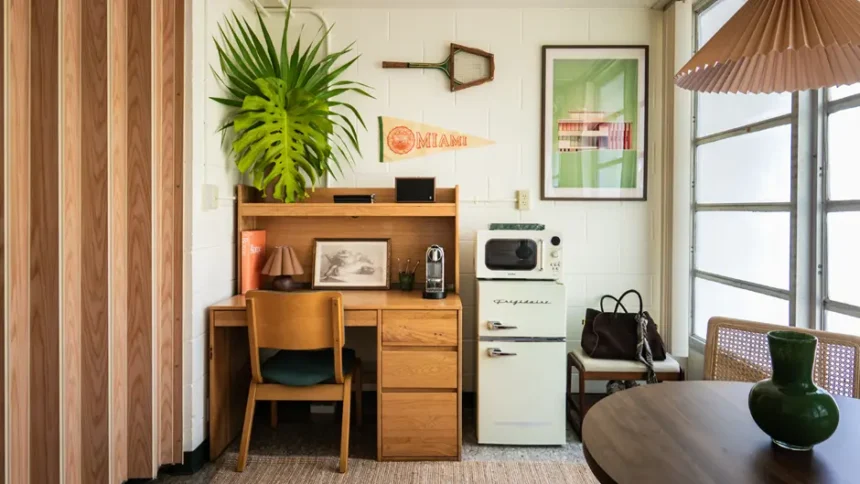The room could be featured in any magazine. It is modern, with artsy posters lining the walls, fringed linen pillows adorning a twin bed covered with a chic cotton duvet. A white bookcase displays crystals, coffee table books, and colorful artwork. Next to it, a stylish throw graces an oak desk chair.
This one-of-a-kind room is one of several designed by Benedetto Rebecca, a recent graduate of the University of Miami School of Architecture’s Master of Science in Architecture, specializing in hospitality design. Rebecca has been working with the University’s Department of Housing and Residential Life to design renderings that offer incoming students ways on how they can transform their dorm room into a showstopper.
Rebecca is one of several students enrolled in the school’s PAIR (Professional Advancement, Internship, and Research) Program, offered as part of the Master of Science in Architecture, said its director and associate professor, Eric Firley.
“The PAIR Program is about finding internship opportunities for our students in architectural firms, companies, and other institutions, and to coordinate these opportunities closely with the students’ academic focus,” said Firley. “The students define a research project with their SOA (School of Architecture) professor and then spend 20 paid hours at the partner firm working on expanding that same project.”
Unlike regular internships, where students are assigned random tasks, the PAIR Program gives students the opportunity to spend both academic and professional time perfecting their project, said Firley. Very often, this project turns into the students’ thesis.
Richard Sobaram, associate vice president for housing strategic initiatives, has been working with Rebecca throughout the past semester and into the summer, hoping that his renderings of how to transform dorm rooms will inspire students to convert their rooms into similarly fashionable spaces.
“He does great work,” said Sobaram. “We hope to offer students these renderings so that they can see how they can turn their rooms into modern, elegant, and stylish spaces.”
Rebecca believes that the built environment shapes human experiences. While designing dorm rooms, he kept in mind that they are more than just living spaces. “They are incubators of student growth, social interaction, and academic engagement,” he said.
Mathilda Ron, a Master of Science in Architecture graduate, participated in the PAIR Program. As part of the hospitality design track, she worked with professor Allan Shulman and the architecture firm OBMI to explore how design can promote wellness in hospitality.
For her master’s thesis, Ron developed The Wellness Room, a hotel room conceived as more than just a place to sleep. It is a curated journey of reconnection and relaxation, designed to support the mind, body, and spirit.
The Wellness Room is structured around six intentional steps that guide the guest through a holistic process of renewal: disconnection, introspection, expelling toxins, cleansing, recovery, and sleep. Each phase is embodied through carefully designed spatial elements and multisensory therapies.
One space features a cool stone-wrapped chamber where silence and darkness promote deep disconnection and mental rest. Others are designed for warm light treatments, including halotherapy—a salt-infused air therapy that supports respiratory and skin health—and red-light therapy, which reduces inflammation and promotes cellular recovery. Every component of the room is aligned with the guest’s internal rhythm, offering a restorative experience through architecture.
“This project transforms the traditional hotel room into a series of sensory experiences, each one crafted to awaken the body, calm the mind, and restore the spirit,” Ron explained.
“In the growing world of wellness hospitality, public spaces have been gaining tremendous attention and transformation, becoming temples of gathering, ritual, and experience,” she added. “Yet the private space, the room where true restoration happens, has often been left behind. The Wellness Room seeks to rebalance that equation by bringing intention and innovation back to the core of the guest’s personal journey.”











